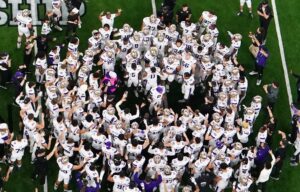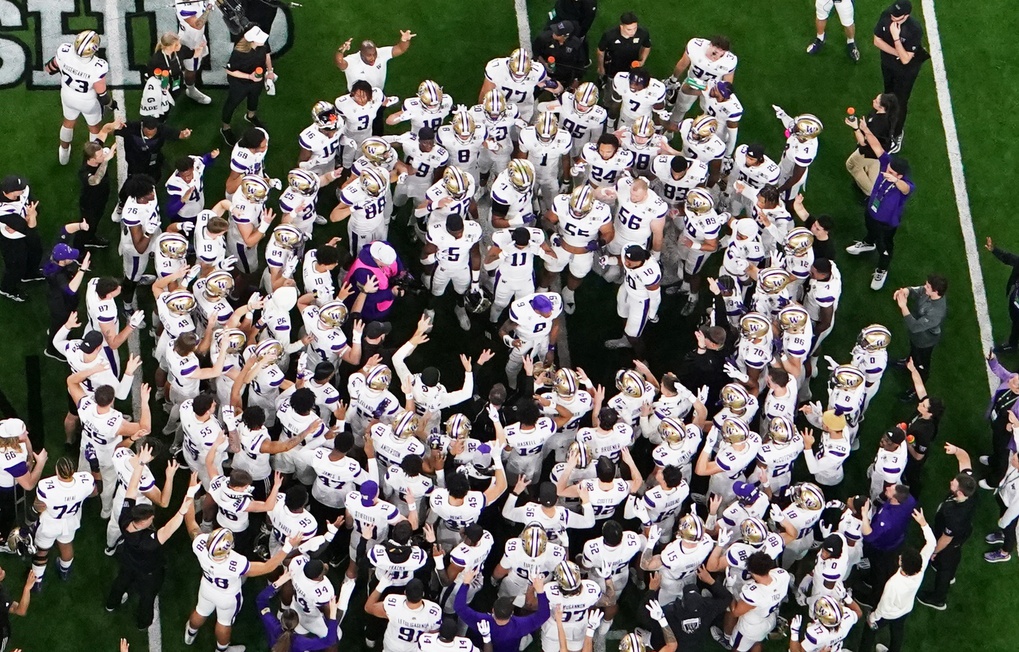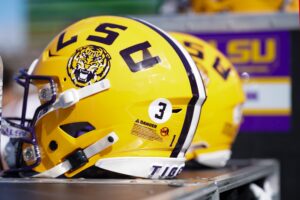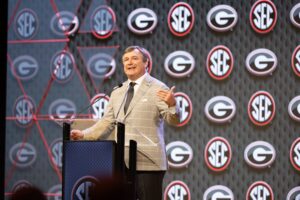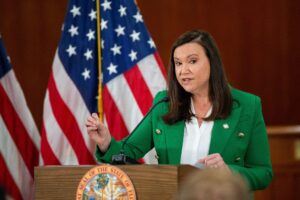As Michigan celebrated its win in the college football championship game, we also had to realize that it was time to say farewell to the Pac-12. Oh, sure it is just for football for today. There is still a basketball season to complete, a men’s and women’s conference tournament, and of course all of the Spring sports. But we all know that it is football that drives the financial bus. And this bus rolled right over the Pac 12, put it in reverse, and rolled over the “conference of champions” again for good measure. And now we see the beginning of the end. Sorry, Pac-12. It’s not us. It’s you.
Sure, the news of the end of the conference came some time ago and stretched out over a year. But now the words are taking place in action right in front of our eyes. The conference that gave us UW legends like Don James, Warren Moon, and Lincoln Kennedy begins the post-football dissolution that will happen quicker than you can say Kliavkoff a dozen times.
Keeping this on the “we” front and not the “me” category, it must at least be noted that this author attended his first conference game back when it was the Pac-8. It was the 1972 season opener with pre-season #1 Nebraska at UCLA. The Bruins were running the veer with a quarterback who went on to fame in a whole different Southern California industry.
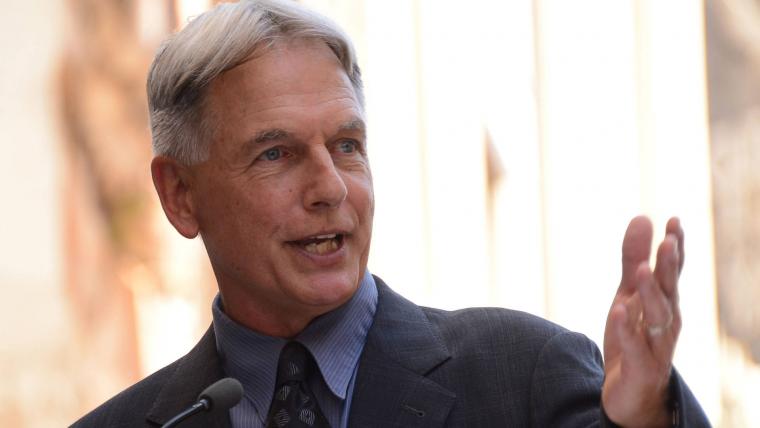
From there it was a decade of every UCLA home game through high school graduation, only to start all over again with a new group of attendees, (they like to call themselves family and friends), for another two decades, before the media world came calling again.
So, to imagine the conference that gave us Terry Donahue, Troy Aikman, Jerry Robinson, and Jonathan Ogden being gone in that same lifetime is more than a little bizarre.
The Conference of Champions Gets a New Leader
Of course, the signs were there for a lot of years for those who could read the tarot cards. Tom Hansen spent 26 years as the conference commissioner, seeing it expand from eight schools to 10 with the addition of Arizona and Arizona State in the 1970s. It was under his watch that the “conference of champions” truly began to materialize with NCAA championships up and down the conference map in a dozen or more sports.
Hansen, a noted Navy officer in World War II retired in 2007 and the slide into chaos began with certainty, if not slowly.
The 10 school presidents and chancellors selected Larry Scott as the new commissioner. Scott had been a professional tennis player in the 1980s with appearances in all of the Grand Slam events. His only real administrative role before this was as chairman and CEO of the Women’s Tennis Association for five years before being pegged for the Pac 10.
There was a record of huge increases in sponsorship money for the women’s tour and in total revenue. There wasn’t a track record of having to compete for finite media dollars against the likes of Alabama, Ohio State, Michigan, Texas, Oklahoma, and others. The conference that gave us Washington State’s Jack Thompson, (the Throwin’ Samoan), and Drew Bledsoe was going to drop a minnow into the water to see if he could hang in with the piranhas.

2011 was the telltale year for Scott, and subsequently for the conference. The conference added Colorado and Utah to expand to 12 schools. It was not the most logical expansion. The conference had always been the home of the perfect round-robin format for sports like basketball. UCLA and USC would spend a weekend in Washington with one playing WAZZU and the other playing UW on Thursday and then they swap for Saturday’s games, as an example. It was clean, it was simple, and it was increasingly behind the times as a wave of conference realignment/additions was going on elsewhere. So, in came the Utes and the Buffaloes. And with them came an expanded media deal.
The Great Media Deal That Handcuffed the Conference
The Pac had been getting 1-2 games per week, mostly on Fox regional networks. Scott signed a deal with ESPN and Fox that would begin in 2012. It totaled $3 billion over 12 years and was the largest deal of its kind in sports TV history.
But therein was the rub…12 years. That is a lifetime in sports media terms. By the time it expires after the end of this current academic year, it will be proven to be an archaic contract. The other conferences have lapped the Pac 12 multiple times over during that 12-year contract. The contracts for the evolving conferences would grow in terms of dollars while being succinct enough in years to envelope the changes going on in conference makeups. Scott and the Pac were stuck for more than a decade.
Over the years, it got worse, and Scott had fewer and fewer answers. The championship games for football and men’s basketball were now more frequently filled by the other conferences. The Conference of Champions was racking up its historic titles in gymnastics, softball, tennis, and the like. That’s not to minimize any of those. Stanford, UCLA, and USC are numbers one through three in terms of total NCAA championships. The three of them combined have more NCAA national titles than any other conference in its entirety. Oklahoma State is fourth and the Cowboys are 55 championships behind USC. The college football championships are not an NCAA-sanctioned event. So while Alabama argues over how many football national championships it has, none of them counts towards the aforementioned NCAA titles.
Safety Among the Uninvolved
But while those championships piled up under Scott, they did not come in the revenue sports. And as the other conferences got chances to renew their TV contracts, the Pac was losing value.
Scott was safe in his job though. He answered to the presidents and chancellors of the universities. The likes of Gene Block (UCLA), Michael Crow (ASU), and Michael Schill (then-Oregon, now Northwestern), never felt the need to rattle the innovation cages to the point of getting overly involved in athletics. Block went years without ever attending an athletic event at UCLA. Then he was dragged by the hand by current athletic director Martin Jarmond.
That lack of accountability and oversight for Scott left him with some horrific decisions. The most blatant, at the time, was the implementation of the Pac 12 Network, launched in 2012. While other conferences were creating a one-channel, all-encompassing network, Scott went regional. There was the flagship station, but each region of the conference had its own channel as well. Being way over his head as a negotiator, Scott mandated that the cable/satellite providers carry ALL of the six regional networks if they wanted the main network.
The Network
DirecTV, the largest outlet in the West never signed on. And when AT&T bought DirecTV, the corporation decided to drop the P12N from its U-Verse outlet. In light of the existing 12-year contractual albatross with the major sports networks, many of the Pac 12 Network games were on at 7 pm on the West Coast. That means most of the rest of the country never saw them. “Pac 12 After Dark” became a kitschy hashtag. What it really meant was there was cool football going on that no one saw.
Between the lack of cable/satellite footprint and the poor game times, the conference’s cable network became a financial weight pulling the schools underwater. None of them, none of them, ever got as much money from it as Scott had promised. The SEC Network is currently seen in 87 million homes nationwide. The Pac 12 Network, for the Conference of Champions, hits 26 million.
And with a lack of shared revenue from the major sports championships, the member schools were starting to bleed. In 2016, ESPN came with a life raft. They would partner on the network. They would take over all the production and related costs in exchange for a majority percentage of the advertising revenue. Scott turned them down in favor of staying independent.
Running Up the Bills and Looking For Help
Scott moving the Pac 12 headquarters from the cozy confines of Walnut Grove, CA to the exorbitantly expensive San Francisco was the nail in the coffin. The conference was paying more than $8 million per year for the rent of the headquarters that also housed the TV network. Meanwhile, Scott was traveling in elite style.
In the Spring of 2019, Scott went on a beggar’s mission, looking for financial handouts from private equity firms. The ask was $750 million. The return was, well, not much. When private equity firms hand out that kind of money, they want a seat at the table. They want seats on the board and some level of ownership. Scott did not have that to offer. His product was owned by the 12-member schools. The best he could offer in his glitzy presentation was that the investors would get a percentage return on the conference that gave us Jake Plummer and Pat Tillman.
Predictably, Scott got nothing. There was one media report that he was offered a $1 billion investment and the school president and chancellors, his CEO group, turned it down. The report was never true. Scott even went so far that Summer, at Pac 12 Media Days, to deny the investment hunt. Last Word has proof of his efforts.
The Covid Year
2020 hit a lot of institutions hard. Scott and his “CEO” group took it on the chin. Late that Summer the conference announced it was going to cancel the upcoming football schedule because of the Covid outbreak. In the press conference, on Zoom, making the announcement, Oregon president Schill was asked if he expected players to transfer out to schools and conferences that were going to play a modified schedule. He replied that he expected the players would be spending more time in the library doing homework like normal students. In subsequent weeks several dozen players either “opted out,” making them eligible for the NFL draft, or moved to other conferences. Schill’s response was indicative of the lack of reality that permeated through much of the old-guard leadership in the conference.
The conference eventually reversed course in October playing a shortened schedule in empty stadiums. The loss of TV revenue and gameday income was not recoverable. Schill is now at Northwestern trying to get the football program out of the remnants of a hazing scandal.
Scott’s contract was set to expire in January of 2021. He expressed the desire to get an extension. Instead, he, and his $5 million per year salary, were shown the door. With some new leadership at some of the member schools, there was attention to getting better. The problem was the conference had already been financially lapped a few times. The time to catch up and save itself was dwindling.
A New Face and a Dwindling Calendar
The most clear choice for new conference leadership was right in front of them. Gloria Nevarez had been a critical part of the growth of the Pac 12 for a decade. She went on to become commissioner of the West Coast Conference. She was a collegiate sports insider. Instead, the 12-member CEO group chose someone no one had heard of. George Kliavkoff was president of entertainment and sports at MGM Resorts in Las Vegas, the city host of the Pac-12 basketball championship. He never stood a chance.

The first order of logical business would have been to meet with the heads, and athletic directors of all his member schools to see what was on their agenda. Per accounts from several of them, he had plenty of group Zoom meetings. He never went to USC, among other schools, to check-in.
With that type of strategy, it was no wonder he was caught off guard when USC and UCLA announced in June of 2022 that they had signed a new membership agreement to join the Midwest-dominated Big 10 Conference. They would leave the 108-year-old Pac conference at the end of the 2023-24 academic year. The new TV contract the Big 10 had gotten from Fox, NBC, and CBS would allow them to allocate approximately $70 million per year to each of its member schools. The best the Pac was doing was about $35 million.
After being in office for around 18 months, Kliavkoff was losing his schools in the #2 media market while he was trying to negotiate a new media rights deal. The school of John McKay, Marcus Allen, Ronnie Lott, Rodney Peete, Lynn Swann, and Reggie Bush was firm in its departure plans. Kliavkoff was trying to at least get the same amount of money from the TV networks that the conference was currently getting.
While no network was willing to openly step to the forefront, as they were heavily invested in the other conferences, Kliavkoff was quickly running out of options. Per several media reports, late last Summer ESPN came with a late offer that would get the remaining 10 schools, minus the LA media market, $30 million per year. Kliavkoff, who had failed to build a significant relationship with his bosses, lacked the cache to get it through. The CEO group told him to counter at $50 million per school. ESPN said no and goodbye.
No Media Means No Money and No Conference
At Pac 12 Media Day in Las Vegas, last Summer Kliavkoff assured the conference beat reporters that a good deal was coming. Colorado athletic director Rick George left the event hours earlier than scheduled. Three days later Colorado announced it was leaving for the Big 12.
The best media deal Kliavkoff could muster was an incentive-laden deal that was streaming only on Apple TV. It would net about $22 million per school. The tsunami was underway. The only schools left now are Oregon State and Washington State. Everybody else has a new conference home starting in late Summer. After abbreviated legal battles, OSU and WAZZU own the rights to the conference and the branding.
But there currently is no conference. Kliavkoff spends all of his “working days” at his vacation home in Montana, presumably polishing his resume. When Washington won the conference championship the first weekend of December, Kliavkoff was there on stage to give them the trophy. But he gave no speech. He didn’t even speak any words before ducking out the back. What could he possibly say?
Packing Up the Furniture
Oregon State and Washington State, under NCAA rules, have two years to rebuild the conference into at least eight schools or move on elsewhere. In the meantime, they are working on affiliate schedules with the West Coast Conference for all sports other than football. The football schedule is going to get a cooperative effort, ironically enough, from Nevarez and the Mountain West.
Larry Scott? Well, no one hears much from him anymore. What could he possibly have to say? Cal and Stanford, the schools that gave us Norm Van Brocklin and Marshawn Lynch, John Elway, and Jim Plunkett are going to be playing conference games in the Atlantic Coast Conference. Someone is going to need to explain Cal’s Joe Roth jerseys to a whole new crowd.
How will the new audiences understand that former Oregon State coach Craig Fertig, (1976-79), playfully took on the nickname The Great Pumpkin? His size, enveloped in OSU orange shirts lent itself to the moniker. There is so much history that is going to get shelved.
Farewell Pac 12. It didn’t have to end like this. It has been a fun ride, but it’s not us. It’s you.
